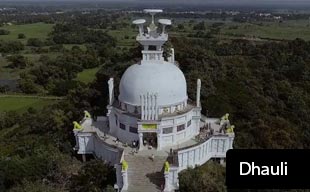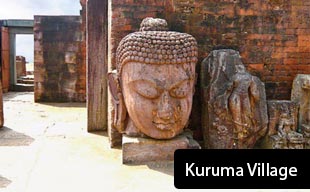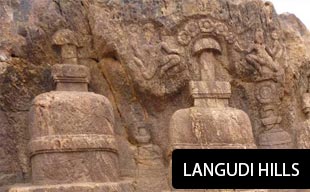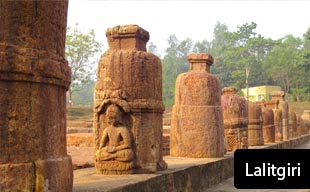
Day 01:- Arrive Bhubaneswar.
Trip to Dhauli 'Kaling War Field', Sun Temple, Konark and Kuruma town for Buddhist unearthing. In transit back one can likewise observe the "Light and Sound" show of Asoka's Kaling War at Dhauli. Over Night/Bhubaneswar Hotel.
DHAULI: - Ashoka had an uncommon soft spot for Dhauli, where the fight was battled. The Daya waterway is said to have turned red with the blood of the many expired after the fight, and empowered Asoka to understand the greatness of ghastliness related with war. He got residences for the loner, guidelines engraved for authorities, elucidated the primary standards of dandaniti for the general population, gave exceptional status to his new kingdom including the stupas at Dhauli. The Rock Edicts found here incorporate two separate Kalinga Edicts. In Kalinga Edict VI, he communicates his anxiety for the "welfare of the entire world". The stone cut elephant over the Edicts is the most punctual Buddhist model of Odisha. The stone elephant demonstrates the creature's foreparts as it were, in spite of the fact that it has a fine feeling of shape and development. On the highest point of the slope, an amazing white peace pagoda has been worked by the Japan Buddha Sangha and the Kalinga Nippon Buddha Sangha in the year 1972 SUN TEMPLE, KONARK: - One of the most shocking landmarks of religious essentialness, a genuine magnum opus of design gladly remains as Sun Temple at Konark. Here the dialect of stone annihilations the dialect of human. The Sun Temple of Konark, regularly called as the Black Pagoda, Built in thirteenth century by King Narasimhadeva-II, of the Ganga Dynasty, the sanctuary is composed in the state of a gigantic chariot with seven stallions and twelve wheels, conveying the sun God. It is an adequate demonstration of the aesthetic grandness of the time. Imagined as an enormous chariot drawn by seven energetic stallions on 12 sets of stunningly embellished wheels- - after the legendary seven steed chariot of Sun God- - the sanctuary was exceptional in its design and execution.

KURUMA VILLAGE: - This Buddhist exhumed religious community having twelve cells and the open patio at the inside. 7.5 kilometers from the world acclaimed Sun sanctuary at Konark, "Kuruma" is a little town. Late unearthings here have revealed the memory of some old relics like the picture of Buddha situated in Bhumisparsa Mudra alongside the picture of Heruka and a 17 meters in length block divider (block estimate 22 cm *17 cm). Researchers are of conclusion this was once of the destinations containing Buddhist stupas portrayed by Hiuen T'Sang. PARSWA DEVATA (GOD) in Oriya Language is "JAMANTAKA" and "ABALOTIKESWAR" and "BAMAN" is Called Three Devata (THREE BIKRAM). This place was overviewed by Archeological Department in the time of 1971 and there is a major lake named as "JAMADHARMA Pond".
Day 02:- Drive to Visit Tarapur / Kaima / Langudi Hills & Arrive at Ratnagiri.
Over Night / Ratnagiri Hotel.
The recent Excavation of Langudi-Radhanagar-Kaima-Tarapur, conforms the ‘Puspagiri Vihar’ of the Chinese Traveler.
TARAPUR: - The current Tarapur unearthing uncovered the ID of 'Kesa Stupa' and the gift of 'Bhikhu Tapusa' for building Tarapur Stupa have been explained. Two traders of Utkal Tapassu and Bhallika turned into the primary lay pupils of Lord Buddha, as per early Vinayak Texts. Eight modest bunches of his hairs were what Buddha gave them, getting rice cake and nectar consequently from them. Last on the dealers kept the hairs in a Stupa (Kesa Stupa) in their local Place.
KAIMA HILLS :- The most entrancing stays of Kaima is a one of a kind shake cut elephant that rises unexpectedly finished the lower rise on the eastern furthest reaches of the slope, confronting the waterway Kimiria. It has been cut out from live shake with magnificent and very naturalistic IIIrd Century BC. STUPA AT TARAPUR. Craftsmanship. The speculative date of the picture has been doled out to the Mauryan time, around the third century B.C. RADHANAGAR: - Radhanagar was an old regal city. An all around outlined city, Radhanagar held mud bulwark same as other old urban areas in India including Ujjain, Kosambhi and Sisupalgarh. Asoka’s Dhauli Rock Edict says that Kalinga's imperial central station amid Asokan period was 'Tosali'. As per the current Radhanager removal, various engravings and other demonstrative confirmations mean Radhanagar as the capital city of 'Tosali'. The current removal has uncovered the remaining parts of the Radhanagar Fort. Shake CUT ELEPHANT AT KAIMA HILLS.

LANGUDI HILLS: - Langudi slope was a noticeable Buddhist seat of learning that prospered until the eleventh century in India. This Buddhist archeological site adorned with arrangement of shake cut Buddhist stupas and a few early medieval Buddhist landmarks and holy places. At Langudi slopes the remnants of a block stupa and a huge religious community still exist. With everything taken into account, the Buddhist remains on the slope demonstrate that Langudi was a huge focus of the Hinayana, Mahayana and Vajrayana Groups of Buddhism. ROCK CUT STUPA & BUDDHA AT LANGUDI.
Day 03:- Visit Ratnagiri / Udaygiri & Lalitgiri Buddhist Monasteries & Stupa. Latter drive to Bhubaneswar. ON- Bhubaneswar.
RATNAGIRI :-An ideal place to have mediation early in the morning & Evening, if someone desire.
The passageway to the main cloister has some marvelous cut statues of Vajrapani and Lokeshwara, adorned on its dividers. There are models from Hindu folklore too, which have stood the trial of time with a square-formed internal yard. The great 10 ft representation of Lord Buddha, occupied with contemplation which is set inside an isolate chamber without a doubt takes a man to divine awareness. Pay special mind to the perfectly cut entryway board set inside the patio and other marvelous sculptural confirmations, scattered everywhere throughout the complex. The unearthings goes back to sixth Century AD. From Gupta Dynasty, and thought to be of Mahayana group.
UDAYGIRI: - Udaygiri, the biggest Buddhist complex in Orissa. The historical backdrop of Udayagiri Buddhist complex isn't much known, however what is without a doubt is that it not as old as Ratnagiri or Lalitgiri. Most presumably, it existed and Thrived between the seventh – twelfth AD. Late removal has uncovered various Buddhist fortunes. It is presently realized that the old name of the religious community here was Madhavapura Mahavihara. A substantial block cloister together with various Buddhist models have been uncovered. There is additionally another block religious community which is still not uncovered separated from an in scripted ventured stone well and shake cut models. The remainder of these is situated at the highest point of the slope behind. Bodhisattva figures and Dhyani Buddha figures are different fortunes recouped from this site. Exhuming work is as yet being done in the Udayagiri Buddhist complex.

LALITGIRI: - Lalitgiri, one of the most punctual Buddhist destinations in Orissa, kept up a nonstop social grouping beginning from the post Mauryan period (322– 185 BC) till thirteenth AD. Too this site kept up a nonstop of essence of Buddhism, unbroken, from third BC to tenth Promotion. Lalitgiri have uncovered leftovers of a vast stupa on the slope. Inside the stupa, two uncommon stone coffins were found with relics of Buddha; this was the principal such find in Eastern India. The stone coffins, similar to Chinese Puzzle boxes, made of Khondalite stone, uncovered three different boxes inside them, made of steatite, silver and gold separately; the gold coffin, which is the last one, contained a relic or dhatu as a little bit of bone. Likewise another fascinating find is that of an east-bound aspidal chaityagriha, worked of blocks, 33 by 11 meters in measure with 3.3 meters thick dividers. This building, the primary such Buddhist structure found in Odisha, contains a round stupa at its inside. Additionally found were a progression of Kushana Brahmi engravings made on shells with cuts on moonstone at the fringe of the building.
Day 04:- DROP AT AIRPORT. (If time permits can visit some of Temples in Bhubaneswar.)
